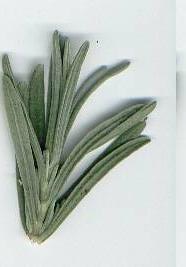
| |
Lavender
|
|

| |
Lavender flowers
|
|

| |
Lavender plants with flower
|
|

| |
Lavender shortly before bloom
|
|

|
|
Lavender inflorescence
|
Lavender is not a common spice, but it is characteristic of
the cuisine of Provence, a region in Southern France.
Provençal cookery makes much use of fresh herbs (which grow to unmatched
flavour in the Mediterranean climate), of
garlic
(see also
tarragon for
aïoli,
the famous garlic mayonnaise)
and even of the most exclusive spice,
saffron,
which is, among others, used for the fish soup
bouillabaisse.
Plenty of fresh fish and sun-ripened vegetables are the basis of
Provençal food.
Herbes de Provence is a spice mixture usually
containing several different herbs (chervil, tarragon, savory, marjoram, rosemary, thyme, lavender and frequently also fennel). This mixture is used for many dishes of the
region, especially fish, but also meat and vegetables; a famous example is ratatouille, a flavourful vegetable stew made of zucchini (or
squash), tomatoes and aubergines.
Outside of France, lavender is an uncommon spice; it should be used with care
and only for robust dishes, since its flavour tends to dominate, imparting a
perfumed, slightly bitter and disagreeable odour to the food if overdosed. Cookbooks suggest
lavender for meat (mutton with its strong flavour is an obvious choice) and
fish; I like the combination of lavender (and garlic) with cheese (e. g., Italian gorgonzola or French roquefort).
Lavender can also be used as an unusual and somewhat extravagant flavouring for
sweets. There is constant rumour of delicious lavender ice cream, but I had
never the opportunity to taste one (see vanilla).
Moreover, lavender can be used to lend
a unique character to home-made jams and fruit jellies. Lavender flowers can be candied
and taste particularly delicious.












